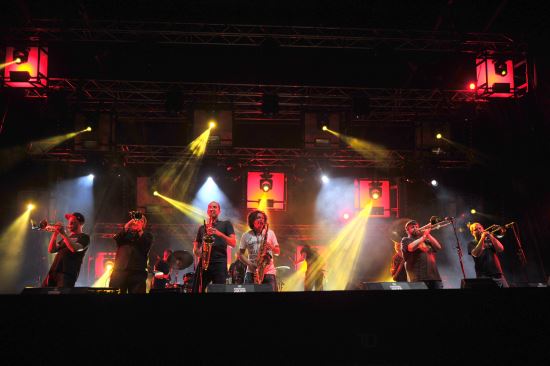Montréal Jazz Festival runs for 10 days, a period in which it completely colonises the arty part of town. The ridiculously high number of slick concert halls in such a small area is reminiscent of NYC’s Lincoln Center, but there are even more temporary outdoor stages in evidence, all offering freebie entertainment, if the indoor gigs are deemed too pricey. Within this "jazz ghetto", Heineken has won the beer battle. No craft ales here, but at least the entire zone is licensed for perambulatory quaffing.
As with so many jazz festivals nowadays, acts often step sideways from the core. Erykah Badu keeps her adoring crowd waiting during a dragged-out interval, and appears completely enamoured with her own poised delivery, too frozen to communicate, not as impassioned as usual. In the realms of tight fest-timing, it is necessary to skip down the avenue to catch Norwegian prog-bombasters Jaga Jazzist at Club Soda, where leaning against its walls is not recommended due to intense bass-vibrating. This combo have refined their precisely thundering math-prog to the point where there’s little space for contrast, with all the dense riffing and propulsive hammering. Shockingly, there are parts where trombone and tuba stood alone, or drums, bass and electronics dropped out, that held an almost revolutionary power due to their absolute switching of sonic tactics.
The Bad Plus Joshua Redman (as the existing trio with their guesting tenor saxophonist style themselves) gave one of their most rousing performances, alternating between driving momentum and derailed scrabbling. The players often tend towards choosing partners for duo activities, contrasting with what the remaining pair are doing. At one point, pianist Ethan Iverson and drummer Dave King set up a repetitive clanging repeat, whilst Redman and bassist Reid Anderson engage in more pliable activities. Redman’s soloing is always infused with a desperate energy, marrying technical flash with emotional crying. He can sometimes appear slightly removed from the action, but certainly not during this gig.
Saxophonist Wayne Shorter seems increasingly uncomfortable onstage in recent years. He takes time adjusting his mouthpiece, or flicking the resistant wire-stem microphone, never seeming satisfied. After about 20 minutes, he finally looks content, and the music starts to grow a different kind of tension, with a bias towards much briefer pieces than is usually the case with this quartet.
High Risk is the latest band convened by trumpeter Dave Douglas, involving a collaboration with laptopper Shigeto, bassist Jonathan Maron and drummer Mark Guiliana, a player not averse to out-drum-machining a drum machine. They’re not making radically new sounds, – this basic style can be traced back to the early 1970s fusions of Miles Davis – but Shigeto is adept at combining elements of dubstep and art-house electroacoustic music, his output defined by a crisp PA. Giuliana is always amazing, striking out with rapid robo-patterns, mixing electro-pads and skins, polyrhythmic to the max. Meanwhile, Douglas blows out a constant stream of deftly crystalline solos across the top of this vibrant spread.
The blues have a notable presence at the fest, not least in the starry presence of veterans James Cotton (harmonica) and John Mayall (vocals/keyboards/guitar). Even though these two turn in fine sets, they don’t transcend the expected, and it is the late replacement for an ailing Taj Mahal that makes an unpredictable impression. Harry Manx (from the Isle Of Man, no less, but living in Canada since the age of six) plays a variety of sliding strings, traversing styles from J.J. Cale to V.M. Bhatt, with whom he actually studied in India. Manx’s band create a unique sound, an evocative, soundscaping blues, trimmed with elements of soul, jazz and Indian classical music.
To find the blues in its natural habitat, we head down to the dark side of the festival’s perimeter, on its own special stage, which boasted a sound system maximised for beautifully-formed guitar distress. Another hot discovery was Jon Addessky & 3rd Degree, although why this local band is named after a single leader is puzzling, as all three lead guitarists take the vocals in turn, as well as the bassman contributing a song. It’s a band full of frontmen, all of them equally loaded to ruck. It was one of those mystical moments: half the festival has been prone to downpouring, and this combo hit the stage just as the deluge ceased, the circumstances just right to make the connection between audience and excessive guitar frazzle, the best blues moments always leaping forth from adversity.
<div class="fb-comments" data-href="http://thequietus.com/articles/18287-festival-report-montral-jazz-festival” data-width="550">


